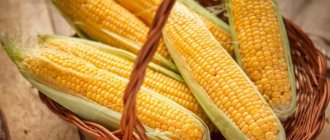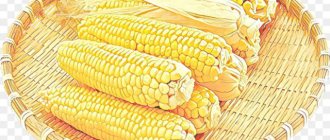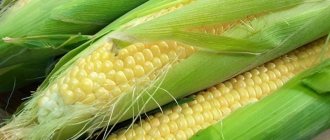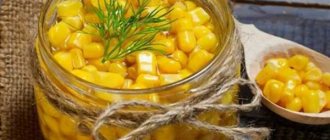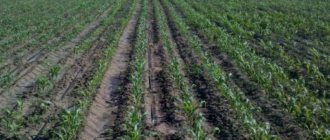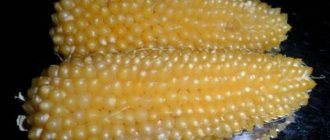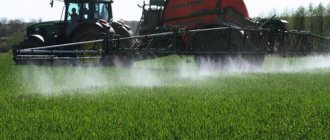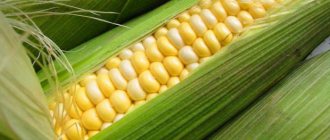Corn is the second most popular grain grown in fields. In summer cottages where the crop area does not exceed 6 acres, it will not be possible to plant a lot of corn. And cleaning several furrows will not cause problems. But if there are several hectares of crops, then you cannot do without agricultural technology. We will tell you in more detail in the article what options there are for harvesting corn, how to prepare the field and carry out long-term storage.
Field harvesting of corn
Timing for harvesting corn for silage
Corn silage is harvested in early autumn to provide livestock with energy and vitamins during the autumn-winter period.
The timing of corn harvesting depends on the growing region and variety. Weather conditions have a significant impact. If the year is dry, then harvesting begins earlier so that natural sugar does not have time to turn into starch.
Before harvesting, the amount of dry matter in the product is determined. You can do this in the following way:
- select several plants located closer to the center of the field;
- at a height of 30-35 cm, cut off the leafy stem mass and twist it into a rope;
- if juice is easily released, then the dry matter is no more than 20%, if there is foam, then about 25%, if there is no liquid, then the dry matter is more than 27%;
- the determination of dry matter in a grain is determined by pressure; if there is no juice when pressing on the grain, then the dry matter has reached the limit of 55%.
Corn silage
The plant is harvested preferably at the stage when the proportion of dry matter in the stems and leaves ranges from 23-25% , in the cobs – 45-55% . Humidity of grain – 35-45% , leaves – 65% . At this time, the content of nutrients in the plant is greatest. If the percentage is higher, then the risk that the green mass will suffer from fusarium or mold increases.
Guidelines for harvesting
One of the main advantages of grain crops is the high level of productivity. On average, from 7 to 10 tons of quality product are collected from 1 hectare. It is actively used in the food industry and farming. The crop is sown around the end of April - beginning of May, taking into account the climatic conditions of the growing area.
And the timing of harvesting corn for grain is determined by the following criteria:
- biological stage of maturity;
- permissible humidity level;
- harvesting method;
- weather.
Deviation from these factors often leads to yield loss. Moreover, unripe grain requires special technology for storing the product. If its humidity exceeds 25-30%, special drying rooms are built. And all this requires additional material costs. An important aspect is also the optimal period when corn is harvested from the fields for grain, silage or cobs. There are several landmarks.
In the southern latitudes, where autumn is relatively warm and without precipitation, farmers wait for the crop to dry out completely. As a result, grain containing only 15% moisture is ready for storage. However, this option leads to loss of yield. After all, by this time the plants sag due to fruits or lie down to the ground. In addition, the cobs crack, losing precious grain.
In the northern regions, where the climate is characterized by short summers and early autumns, they try not to delay harvesting. Otherwise, it will suffer from frost or the “rainy season” will begin. Because of this, grain may lose its viability and feed value.
If there is a black dot in the fruit where the grains attach to the cob, it means the crop is fully ripe.
Stages of maturity
The energy value of silage depends on the degree of maturity of the crop. There are 3 main stages of cob ripening:
- Dairy _ When the plant has formed light yellow grains, when pressed they release milky white juice. The taste of corn is sweet, the proportion of dry matter (DM) does not exceed 35%. Corn becomes milky ripening on days 17-20 from the moment the flower is fertilized.
- Wax . The stage of plant maturity when the grains harden and darken. The inner softness is still preserved. The proportion of dry matter increases to 45-50%. Wax maturity occurs approximately 25 days after pollination of the plant.
- Biological . The full stage of ripening, when pressing on the grains makes it impossible to crush them. They become hard, tough, and acquire a rich color. The stage begins 1.5-2 months after pollination. The dry matter content in the product reaches 55%. And if a black dot is visible at the tip of the grain, which is easy to separate from the cob, then the SV reaches its maximum value.
On a note! The dot at the base of the grain indicates that the growing season has ended. In rainy summers, the dot darkens earlier than expected.
Biologically ripe corn
When the plant has reached full ripeness, the cobs are harvested for grain; milky-wax or waxy ripeness is required for silage. At the stage of milky ripeness, corn is harvested for green fodder.
Stages of maturation
The first stage of ripeness is called milk stage. It is determined by the light grains that are visible on the cob. When pressed, a sweetish white liquid comes out. The fruit is densely covered with leaf blades and moist hairs of a soft structure. At the base it is colored brown.
The wax stage occurs when the grains acquire a light yellow color and medium density. White liquid no longer comes out of them, and when pressed, dents remain. Over time, dramatic changes occur in the seeds. The sugar components are converted into starch and the liquid into dense pulp.
At the last stage of ripening, corn seeds have a rich yellow or orange color. The leaf blades take on a light brown tint, begin to dry out and are easily detached from the cob.
Each stage of corn ripening has its own moisture content. Milk ripeness - 58%, waxy - 35%, full - 26%.
Harvesting for silage
Breeders have developed crop varieties that are sown specifically for silage. For example: “Argentum”, “Eurostar”, “Voronezhsky 158” and 160 SV. Basically, hybrids are planted that have increased green mass, are tall, and are resistant to disease. Harvesting for silage is carried out in several ways.
Agricultural technology
The main advantages of agricultural technology:
- harvesting is carried out quickly;
- human physical labor is minimally involved;
- The yield and fertility of crops increases due to regular planting and digging of the earth, carried out with the help of units.
Corn harvester
The main equipment for harvesting corn is a forage harvester. It is important to use a powerful cleaning machine that meets a number of requirements:
- The cut of the stems should be at a height of 15-20 cm from the soil . High mowing affects the quality of feed and its digestion in animals. In this case, the overall yield will decrease by 3-5%, but the concentration of nutrients will be maximum.
- Simultaneous cutting and chopping of green mass . The length of the plant parts is no more than 7 mm, the grains are thoroughly crushed.
- Loss of green mass should not exceed 1.5% . At the same time, clogging of the combine prevents the collection of vegetation, which is also unacceptable.
The number of parts of a given length is 65-70%. With proper organization of the combine operation, the quality of the raw material will be high and losses will be minimal.
Equipment and principle of cleaning
The self-propelled harvester is equipped with powerful knives that chop the plant in a matter of seconds. After mowing and chopping the vegetation, the mass is poured into a machine, which transports the raw material for further processing and storage.
Examples of self-propelled combines: NASH-870K, SR-2000, KSK-100A, Yenisei 950/954. Also suitable for harvesting is a tractor to which a trailing mechanism is attached, for example KPKU-75.
Corn header NASH-870K
The cleaning principle is as follows:
- The cutting unit is set to a given height.
- The raw material is cut, the corn is pressed by rollers, and then the product is fed to the drums.
- The vegetation is chopped into pieces; the cutting length can be changed from 5 to 15 mm depending on the technical model of the cultivator.
- The re-shredder completes the work process. Flattening rollers, also known as crackers, crush grains into pieces so that animals can easily consume and digest the product.
- After grinding, the mass is transferred through a silo to a truck with a trailer for transportation to storage.
On a note! Modern combines are equipped with detectors that warn of foreign metal and non-metallic objects that may get into the drum. If you don't have a device, you can install it yourself.
Combine harvester KSK-100A
The finer the silage, the easier it is to compact and store. The density of the mass is small, and it must be delivered to the granary in the first 2-4 hours after harvesting. It is rational to have several cultivators so that the work process occurs with minimal losses.
Unit movement methods
The methods of movement are determined depending on the size and topography of the field. The main directions of working moves are presented in the table.
| Gone | Diagonal | Circular |
| Working progress along the site | At an angle to the sides of the site | Move to the center or to the periphery of the field |
| Movement patterns : shuttle; dump; waddle; alternating waddle/waddle. | Movement patterns : diagonal shuttle; diagonally cross. | Driving patterns : loopless one-way turn; "closed loop"; turning in reverse; rotation at an angle of 45°; for areas of incorrect configuration. |
The rut method is used to harvest rectangular fields whose length exceeds 500 meters.
In compact areas (land length less than 400 m) with small ridges, the circular harvesting method is more often used. The advantage of the method is that the number of idling turns is reduced. In areas from 100 to 350 m, the “closed loop” method or with a reverse turn is used. 45° swaths are suitable for fields over 500 m.
Alternating pens huddled/waddled
The direction can be left-turn, right-turn, mixed. Processing of the working area is divided into one-, two- and multi-pen.
In terms of complexity, turns can be simple or combined.
Field cleaning
The choice of movement method depends on the following factors:
- headland width;
- cultivator model and its performance;
- condition of the site, its slope, area.
The method of movement of the unit is selected by a specialist, taking into account all growing factors.
Corn grain moisture at harvest: formation, accounting, significance
When moving north, grain moisture during harvesting of corn hybrids increases and in Polesie, as a rule, it is 30-35% in early ripening forms. Therefore, under these conditions, the sign of dry matter accumulation comes to the fore.
The loss of moisture from corn grains during ripening is a complex integral process that depends on many factors:
- physical and biochemical properties of corn grain,
- morphological characteristics of the head of cabbage (thickness of the core, linear dimensions of the grain, size of the corn grain, number and ability to open wrappers, drooping of the head of cabbage, timing of the appearance of the black layer in the grain, consistency of the endosperm),
- biological and ontogenetic properties of the corn hybrid (duration of the latent phase, drought resistance).
When characterizing the duration of the corn growing season, researchers usually distinguish two main periods:
- formation of vegetation organs,
- formation of generative organs: inflorescences, flowers and reproductive organs (fruits, seeds).
This division of the growing season of a corn plant helps to identify indicators convenient for preliminary assessment: the duration of the germination period - flowering of 50% of the cobs and grain moisture during harvesting. Note that monitoring the period of germination - flowering of 50% of the cobs allows us to fairly objectively differentiate the range of corn hybrids by the duration of the growing season and distribute genotypes into ripeness groups. However, this indicator characterizes only the first half of the plant’s growing season, is the equator in the implementation of the genotype development program and does not reflect the complete picture of the entire period, in particular the formation and ripening of corn grains.
For the conditions of Ukraine in the 80s, the number of days required for the complete ripening of corn hybrids of various ripeness groups was determined in accordance with the needs of the genotypes in the sum of effective or active temperatures to complete the growing season, which was later clarified in connection with climate changes and in accordance with growing area. Thus, to complete the growing season in accordance with the calculated total number of days and according to certain average values of ripeness groups for 19 years of research during the germination - flowering period, 50% of the ears for the second half of the growing season are needed: for early ripening corn hybrids - 46.4 days, mid-early - 57 .9, mid-season - 59.8 and mid-late - 66.7. This theoretical calculation highlights an interesting trend that should characterize a hybrid corresponding to the ripeness group.
To fully implement the ripening program for early-ripening forms of corn, the second growing season should be 13.5% less than the first, for mid-early and mid-ripening - both periods at the same level, and for mid-late forms - 5.4% more. So, with optimal sowing dates and subject to compliance with the technologies for growing corn hybrids, the ripening of early-ripening hybrids can be expected in the second half of August, mid-early - in early September, mid-ripening - in the second ten days of September, and mid-late - in early October.
One of the most popular methods for recording the completion of the growing season is to record the physiological maturity of the dark layer at the base of the grain , which appears as a result of the death of the leading vessels and its separation from the mother plant, which usually leads to an acceleration of moisture loss by the corn grain and the cessation of dry matter accumulation. While observing this indicator, the researcher is faced with a number of problems that interfere with the rapid determination of the presence of a black layer: damage to plants, determining the date of recording, uneven appearance of the black layer along the stalk and the presence of its shades, etc. It is interesting to note that in the collection of the maize breeding laboratory of the DU ISGSZ NAAN there was a line DK400, which did not form a black layer when the fork separated from the plant. This early maturing line was characterized by a slow rate of moisture loss from the corn grain after reaching its content of about 30%, and also annually exhibited grain germination on the plant in the event of a delay in harvest, indicating the absence of separation of the grain from the influx of nutrients stimulating the awakening processes of the embryo. The corresponding feature may be associated with the presence of vivipary genes.
According to some authors, at full ripeness, the moisture content in the corn grain fluctuates between 28-37% - when the supply of dry matter stops and the process of reducing the weight of the grain begins due to loss of moisture. That is, the phase of complete ripeness completes the ontogenetic cycle, but for some time life processes take place in plants, aimed mainly at preserving the grain and preparing it for the next growing season. They are accompanied, first of all, by a gradual decrease in the moisture content in the corn grain, which is due to the genetic characteristics of the sample. The quality of the seed, the characteristics of commercial grain depend on how the natural process of moisture loss occurs in the corn grain, and the economic and economic components of the evaluation of the hybrid are determined.
For mass assessment of breeding material, such an economic indicator as “grain moisture content at harvest” is convenient . It indirectly indicates the precocity of the genotype, and it is obtained almost incidentally when taking into account the yield. However, to improve the accuracy of this indicator, it is important to determine the time of collection in order to identify the differentiation of samples and find standards that allow one to clearly characterize the corresponding ripeness group. The search and use of standards for mass evaluation is practically the only simple measure for rapid preliminary differentiation of genotypes in breeding programs. When determining such reference samples, it is important to identify forms with different types of moisture loss from the corn grain after ripening in order to increase the accuracy of the assessment of the material when detecting a ripeness group. Thus, the economic indicator “corn grain moisture at harvest” is one of the most popular criteria in breeding and technological research with corn when determining the nature of the course of the second half of the growing season, but to increase its objectivity it is important to clearly establish the variability of this characteristic over the years and its manifestation during interaction of genotype and environmental conditions.
In Ukraine, the moisture content of corn grains at harvest varies significantly depending on the climatic zones of cultivation. Thus, at optimal sowing times in the Steppe, the moisture content of corn grains can be at the level of 7-9%, and on average 14-19%, in the Forest-Steppe it is usually 20-25, in Polesie - 30-35%. In addition, in the fall, appropriate weather conditions are created under which natural moisture loss practically stops and can be leveled out among groups. According to climatic zones, the objectivity of assessing the duration of the growing season in Ukraine will increase from south to north, but it is important to identify harvesting dates that can better differentiate genotypes based on the moisture content of corn grains.
The environmental variability of the period of germination - flowering of 50% of the cobs and grain moisture at harvest have been studied by a number of scientists in the aspect of studying the duration of the growing season. Despite the significant variety of methods for assessing corn samples by the length of the growing season, these two characteristics are an indispensable accounting basis used to identify the early maturity of genotypes. It is important to know the dynamics of variation of these component characteristics for accurate prediction and determination of the implementation of genetic information in the direction of the ontogenesis vector, which is carried out through the interaction of various factors: year, agricultural technology, geography. It should be noted that the climate changes that have been observed recently have also been reflected in the overall reduction in the germination period - flowering of 50% of the cobs for three days and the moisture content of corn grains at harvest - by almost 5%. Such paratypic factors affect not only the quality of assessment of genotypes for early maturity, but also the priorities of various biotypes in production.
Modern selection of early ripening corn hybrids is developing mainly in two directions: the creation of hybrids of northern and southern ecotypes. Moreover, the tasks and source material for each of them are different. In particular, for corn hybrids of the northern ecotype, the following traits are of great importance: neutral photoperiodic response to long days; accelerated accumulation of dry matter in grain; resistance to cold (especially at the beginning of the growing season and at the end), endurance of minor frosts; tolerance to crowding of crops, high resistance to lodging, etc. For early ripening corn hybrids of the southern ecotype, these are, first of all, resistance to drought and heat, low moisture content of corn grains during harvesting, high seed productivity of parent components, etc.
Thus, the selection of corn for early ripening has multi-vector directions, depends on the conditions for growing hybrids and includes a system of traits. It should be noted that genotypes that rapidly lose corn grain moisture during ripening often reduce yield, particularly in dry, hot conditions, and are characterized by low adaptive resistance. This feature is associated with the mechanisms that determine the formation of low moisture content of corn grain during ripening. Some components of this process can lead to a significant reduction in corn grain yield in the Steppe as a result of the opening of the cob wrappers and their drooping. Due to the fact that in most foreign-bred corn hybrids it is these traits that cause accelerated loss of moisture from the grain, we studied their effect on the weight of 1000 grains in genotypes with different grain consistencies and on the dynamics of moisture loss by the corn grain during ripening.
For the experiment, three-line hybrids of corn FAO 200-220 were used: Kremen 200 SV - with a siliceous grain type, Runo 198 SV - with a flint-toothed type and Kadr 217 MV - with a toothed type. Sowing was carried out on May 3 with a special selection seeder. The moisture content of corn grains was determined by the standard method, starting from the 30th day after flowering of the cobs, and subsequently each sampling occurred six times after 10 days. Modeling of the “fork wrappers opening” feature was carried out by removing the wrappers at the beginning of their yellowing and leaving the forks under the insulator to avoid their damage.
The drooping of the cobs was simulated by tilting them and fixing them to the stem with a rope at the same time as when determining the moisture content of the corn grain. The study of model traits was carried out on 30 plants, which were distributed into three replicates.
Plants that were not subject to artificial changes were considered standard. Corn was harvested in the first ten days of October and the weight of 1000 grains from each head of cabbage was measured by selecting 100 grains from its middle.
An analysis of the loss of corn grain moisture showed that the siliceous hybrid Kremen 200 SV on the 30th day after flowering had significantly the lowest grain moisture compared to the siliceous-tooth hybrid Runo 198 SV (except for the third year of research) and the tooth-like Kadr 217 MV (Table 1 ) . However, subsequently the rate of moisture loss by the flint hybrid corn grain slowed down compared to the other two. On average, over the first two 10-day periods, the grain of siliceous-toothed and dentate hybrids lost from 12.1 to 13.2% of moisture, and siliceous - 9.2-11.3%. Despite the intense rate of moisture loss, in the tooth-like hybrid, due to the high initial indicators, the moisture content of the corn grain was significant in almost all selection options.
When considering the nature of moisture transfer by corn grain, it was noted that the rate of decrease in grain moisture content was different depending on weather conditions during the years of research. Thus, in the first year of research, the peak period was 50-60 days after flowering, when the decrease in humidity in the studied hybrids ranged from 13.7 to 18.1%, and in the third year - on the 40-50th day and amounted to 13.5- 16.3%. During these periods, high air temperatures and a lack of precipitation were observed, which led to accelerated moisture loss by corn grain. It should be noted that in samples with intense rates of grain drying, damage to the leaf apparatus was observed due to drought. That is, the accelerated moisture transfer of corn grains during peak periods may indirectly indicate the drought resistance of the sample. In the last two periods (60-70 and 70-80 days), the loss of moisture in corn grain slowed down very much and ranged from 0 to 7.7%.
Thus, among the three samples, the best moisture yield was noted for the flint-tooth corn hybrid, and the tooth-tooth hybrid, despite its high rates, had high absolute values of grain moisture. In the siliceous hybrid, this indicator in different periods of selection had mainly average values, however, the rate of moisture transfer by corn grain until the 60th day from flowering was slow compared to other forms.
The period for applying the modeling of the signs “opening of fork wrappers” (Photo 1) and “drooping forks” (Photo 2) (on the 30th day after flowering) was chosen based on preliminary data on the beginning of yellowing of the wrappers at these times, which is the start for their disclosure. Also during this period, early drooping of corn cobs is observed, however, it should be noted that they also droop at a later date, when the moisture content of the corn grain is already below 30% and the plant is completely dry (photo 3). If the heads of cabbage droop at such a late date, then this sign can have a positive effect not only on reducing the moisture content of the corn grain, but also on its damage to diseases.
Observation of the dynamics of moisture loss by corn grains with drooping cobs and without wrappers showed that the rate of moisture loss was significantly higher in plants with the modeled traits than in the control ones (figure). A significant acceleration was noted in the first accounting periods. Thus, over the period of 30-40 days in the first case, the corn grain lost 6.3-11.8% more moisture, and in the period 40-50 days - 11.0-17.5% more than in the second. The acceleration in the second selection period can be explained by the general aging of plants. Subsequently, the rate of moisture loss levels off and differs little from the control plants, however, the absolute values of moisture content of corn grains in cobs with the simulated characteristics were always lower. It should also be noted that early drooping forks had better indicators of moisture loss by grain.
A study of the simulated corn head traits “wrapper opening” and “fork drooping” revealed that these traits always negatively affected the 1000 grain weight (Table 2). The most negative reaction to the removal of wrappers and drooping of the head of cabbage was observed in the hybrid Kremen 200 SV, in which, on average, over the years of research, the decrease in the weight of 1000 grains was 20.3 and 27.0%, respectively. The tooth-shaped corn hybrid Frame 217 MV responded less to the modeling of these traits, and on average over the years of research the depression in the weight of 1000 grains was 13.7 and 19.8%. However, in the first year of research, when removing the wrappers, this corn hybrid showed a maximum reduction in 1000 grain weight compared to other hybrids. It should be noted that the reaction to the modeling of these traits in all hybrids was of the same type and in different years differed only in the level of depression. Thus, when the wrappers were opened, on average per year, the decrease in the weight of 1000 grains ranged from 9.5% in the first year of research to 26.8% in the third, but in drooping ears of corn the depression was always greater by 6.1-8.3 %.
Thus, three characteristics of corn were analyzed: “endosperm consistency”, “wrapper opening” and “fork drooping”, which directly affect grain moisture content during harvesting.
It was revealed that the flint-tooth hybrid Runo 198 SV was characterized by the best rate of moisture loss of corn grain during ripening and had its minimum value at harvest (on average 14%). The siliceous hybrid Kremen 200 SV was characterized by low rates of moisture loss, however, the high intensity of dry matter accumulation at the initial stages of grain formation provided the corn hybrid with lower grain moisture content than in the tooth-like Frame 217 MV. Therefore, when creating corn hybrids for Steppe conditions, the consistency of the endosperm is not decisive in the formation of the characteristic “moisture content of the corn grain at harvest,” but its role may increase in more northern latitudes, where the rate of accumulation of dry matter is a priority.
The formation of the moisture level of corn grains during harvesting depends on the course of two influential processes: the rate of accumulation of dry matter in the grain and the loss of its moisture after ripening, the nature of which is closely related to the consistency of the endosperm. During the accumulation of dry matter, siliceous forms have an advantage, and at the end of ripening, the decrease in moisture in the grain occurs better in tooth-like samples. Combining two subspecies in one genotype can have a positive effect on the speed of the corresponding processes.
Acceleration of moisture transfer of grain genotype due to various selection accommodations negatively affects the overall productivity of the plant and resistance to drought. Improving the moisture transfer of corn grains through opening or loosening the cob wrappers and in the case of early drooping, reduces the weight of 1000 grains, especially in dry conditions, by up to 30-40%, respectively.
V. Cherchel , Ph.D. agricultural Sciences, State Institution Institute of Grain Crops NAAS
Harvesting for grain
The crop is grown to collect grains for the following purposes:
- consume fresh and boiled;
- preserve;
- grind into flour;
- squeeze out oil rich in healthy fats;
- produce starch, molasses, baby formula, since the product does not contain gluten;
- In economic areas, dyes, alcohol and other substances are obtained from corn grains.
The timing of harvesting depends on the degree of maturity of the seeds and their moisture content. In the milky and waxy stages, the humidity of the crop is still high, the grains are difficult to separate, and there is a high probability of collecting incomplete or damaged cobs. Corn harvesting for grain is carried out at the stage when the proportion of dry matter in the seeds reaches 60-65%. In this case, drying occurs at lower costs.
Corn harvester for grain
Sometimes agronomists harvest corn much later than expected, waiting for cold weather and snow. But the losses of late harvesting are obvious: it is more difficult to mow sagging plants, and frozen ground or snow impede the movement of equipment. Some of the grains rot and fall off when wet corn is collected. And precipitation and cold reduce the taste of the crop.
Early harvesting will also not benefit agronomists. If the seeds are removed at the stage of high grain moisture, they will be easily crushed, and drying will bring unwanted costs.
Field preparation
Before harvesting, the farmer determines which method to carry out the harvesting process. There are 2 main methods:
- Combine cut of cobs. May be with or without cleaning.
- Combine harvesting with threshing of raw materials.
The difference between the methods is that harvesting with threshing does not involve sampling and screening out low-quality cobs. In this case, the raw materials are used for feed purposes, that is, not for food and seed procurement, but more often for animal and bird feed.
For highly productive livestock, corn is also harvested for carnage - this is flattened grain, the moisture content of which is 28-40%, preserved in sleeves. Such grain is harvested at the stage of waxy ripeness at a humidity of 35%.
What is carnage corn?
Field preparation comes down to the following steps:
- Before the work process, it is necessary to determine in which direction the equipment will move. Mostly the direction is set the same as when sowing a plant.
- Then swaths are made along the site, and the distance of the headlands is measured. The width of the paddocks is several times less than the length of the field. The parameter is calculated so that the width is equal to the double grip of the combine.
- When the field distance exceeds 1 km in length, then the equipment makes a main swath of 6-8 meters every half kilometer.
Corn swaths
Combine harvesting cobs
The method is used for grains that have reached a dry matter content of 55 to 65%. Corn is cut with combine knives and cleaned of dry vegetation (stems, leaves) in a cob peeler.
Using detachable plates, the stems are separated. Next comes the release of the seed cobs through the auger. An intermediate conveyor moves the unthreshed plants into the clarifier. The grain is poured into the bunker separately from the stems and heap. The width of sowing rows does not exceed 90 cm, the distance between plants is from 15 to 25 cm.
Combine harvesting cobs
Harvester options:
- Khersonets-7;
- trailed Tornado-80;
- trailed unit KKP-3;
- hinged front attachment PPK-4.
The quality of grains largely depends on the operation of the combine. First, the grain is threshed in stationary hangars, after which the product is placed in storage.
There are a number of requirements for the units:
- the number of peeled cobs must be at least 95%;
- cutting plants at a height of 10 to 15 cm;
- broken cobs from 2 to 5%;
- grain in the heap no more than 1%;
- yield loss from 0.5 to 0.8%.
Tornado 80
The average amount of grain harvested per 1 hectare is 17-19 tons. In 1 working day, the combine harvests up to 5 hectares.
Combine harvesting with cob threshing
The moisture content of the grains at the time of harvesting should be 28-30%. The combine, while harvesting, pulls the stems into the cob separation compartment. They are tightened with plates, and the cobs and green mass are separated. The cobs move through the auger for further distribution and cleaning. Then they are fed into the thresher and the grains are poured into a cart along the second conveyor. Next, the product is loaded onto a transit truck for transport to hangars.
Part of the heap remains on the field, while other vegetation is crushed in a drum and poured through a silo into the cargo body of another vehicle.
Combine harvester KSKU-6
The agrotechnical requirements of the combine must meet the following parameters:
- grain purification of at least 95%;
- crushed product no more than 2.5%;
- underground 0.9-1.2%;
- grain loss behind the combine is 0.5-0.7%.
Popular models of combines for harvesting with threshing are KSKU-6A, Khersonets-200 and others.
Harvesting corn on the cob
In garden plots, the crop is often grown as food for domestic animals. However, young cobs are used in cooking. They are usually picked by hand.
The ripeness of the fruit is determined by the signs:
- the grains have a soft yellow tint;
- juice flows out of them when pressed;
- the leaves are pressed tightly to the cob and are difficult to tear off.
In spacious fields, corn on the cob harvesting begins after the fruits have fully ripened. Ripe specimens are inclined in the opposite direction from the stem. Dry hairs are colored brown. If they are reddish and wet to the touch, the corn is not yet ripe. The cob seeds are dense and do not release any liquid. Most often, whole fruits are collected to obtain planting material.
To harvest corn, choose a time when the weather is clear, dry. As a rule, they use a special technique that removes dry leaves and hair from the cobs.
Cleaned corn is transported first to open areas and then to storage where good ventilation is installed. If the fruits are harvested ahead of time, they may become moldy. Therefore, they are dried in special rooms.
Some varieties of crops bend towards the soil after biological maturation. Such specimens are difficult to remove even with modern technology. The problem is solved with the help of workers who collect the cobs by hand. To avoid such problems, corn varieties with a stable stalk are initially selected.
Cleaning and drying after harvesting
Freshly harvested raw materials are wet and contain mineral and organic impurities, so they are processed before storage. Main processing steps:
- sorting;
- cleaning;
- drying;
- ventilation.
Sorting is carried out on machines at a speed of 20 tons per hour. Sieves separate grains by size into small, medium and large. The product is separated from impurities in separators. The product is purified using modern devices with an average productivity of 12-15 t/h.
Industrial grain processing
An important step is drying; adherence to the correct technology is necessary. When the moisture content of the corn grain does not exceed 15%, it can be immediately sent for storage, after being cleaned.
If the moisture in the grains is 16-17% or higher, then drying is required. Dryers with temperatures above 40°C are suitable for feed grains. For food production, the temperature is set from 35 to 40°C.
Mobile grain dryer
There are several types of dryers:
- mine (t = 50°С);
- drum (t = 55°C);
- chamber (t = 40°C).
The grains must be processed within 4-5 hours from the moment of collection. If more time passes, the likelihood of fungi appearing among the grains increases. Ventilating the product reduces the high humidity of corn grains and prevents their diseases. Ventilation is carried out with warm air.
On a note! Corn quality standards are set out in GOST. The standard describes in detail what indicators must be met for food corn and animal feed.
How to store the harvest?
The harvested crop must be properly stored to prevent spoilage and loss of nutrients. Here are the most popular ways to store grains, taking into account their purpose:
- Industrial or feed corn grain should be stored in bulk in warehouses, bunkers or elevator silos. The height of the embankment can be determined by the capabilities of the storage room. It must be comfortable for normal maintenance of raw materials and quality control.
- Feed raw materials can also be stored in metal silo towers. In this case, you will need to constantly monitor the temperature of the raw materials. Particular attention will have to be paid to the upper and lower layers of the embankment to prevent condensation from appearing in them. This often occurs when the temperature in the towers changes.
- Grain on the cob should be kept in a dry and well-ventilated area, the humidity in which is very low and does not exceed 15%. The optimal height of the cob mound is up to 1.5 m. Before storing them, you need to carefully sort them out, remove all the leaves and dry them to a moisture content of 13-14%.
- Keep grains in plastic containers, cardboard boxes or fabric bags. In the latter case, you need to ensure that the fabric is not saturated with moisture, otherwise the seeds will lose their ability to germinate. Grain in this form can be kept in an unheated room for up to 24 months. Its humidity should not exceed 13%.
- At home, corn can be stored in the refrigerator. First you need to clean it well, soak it in salted water and acidified with lemon juice, and then put it in bags and throw it in the refrigerator, but it will need to be consumed within 10 days.
- To store the cobs in the freezer all winter, you need to alternately dip them for 2-3 minutes in ice and hot boiled water, and then dry them and wrap them in cling film.
Harvesting corn involves a number of rules and features, depending on whether it is collected for silage or grain. The difference lies not only in the harvesting process, but also in the principles of determining the optimal timing of work and the units used.
0
0
Copy link
Further storage
The seeds are cooled before storage. Cold stops the activity of microorganisms, which allows you to preserve grain for a long time. Corn storage facilities include silos, bunkers, warehouses, and hangars. The grains are placed in bulk in the areas and the humidity and air temperature in the room are monitored. Optimal conditions for grain storage:
- temperature +8-10°C;
- indoor humidity 55% .
Commercial grains are stored for 1-2 years at a seed moisture content of 10-12%. If the moisture in the product is more than 17%, then the maximum shelf life is 1 year.
Storing corn grain in warehouses
Fact! Agronomists have experimentally proven that grains that were stored without access to air and at low humidity have the maximum percentage of germination even after decades.
When the humidity of corn is high (23-27%), the grains can be stored at a temperature of +4°C for no more than 2 months, and at -1°C the period increases to six months! Therefore, in order to keep raw materials in a salable form, the storage temperature is often lowered to negative levels.
Quality control
During the storage period, control the temperature, humidity, color, smell, and purity of the product. Particular attention is paid to indicators of pest and disease infestation.
The quality of corn must comply with the standards established by GOST 13634-90 “Corn. Requirements for procurement and supply." The standard applies to corn in grain and on the cob, harvested and supplied for food, feed purposes and for processing into animal feed.
The basic norms in accordance with which payments are made for commercial corn grain are given in the table.
| Indicator name | Norm |
| Grain moisture, % | 14,0 |
| Weed impurity, % no more | 1,0 |
| Grain admixture, % no more | 2,0 |
| Pest infestation | Not allowed |
What to plant next year after corn
Corn suppresses weeds as it grows. Eventually the earth gets rid of them. You get a clean field without weeds. A culture with a powerful root system. Decomposing in the soil, the underground part enriches the earth with useful substances. The only drawback is that decomposition is slow. To speed up the procedure, the field is plowed, crushing the root into small pieces. Various crops can be planted on the site. Among them there are favorable and undesirable plants.
Favorable crops for planting
After planting corn, the field is loosened well. Prefers this soil for next year:
- potatoes, with additional mineral fertilizers;
- sunflower. The same sunny areas suit him; they have common moisture requirements;
- fava beans, peas. They love weed-free soil;
- red linen;
- beets of all types;
- winter grain crops.
Unwanted
Owners of pets can plant clover, lupine, and alfalfa after corn. Plants are green manure - they enrich the soil and provide food. But with their planting, the field will again be overgrown with weeds.
How to grow corn?
General rules that will help you grow a good harvest.
| Air temperature | +12–25 degrees |
| The soil | Shouldn't be sour. Podzolic, peat and chernozem compositions with good aeration are best suited. |
| Predecessors | The best predecessors are cucumbers, potatoes, legumes, tomatoes, and onions. |
| Fertilizers | In the fall, it is recommended to apply potassium-phosphorus fertilizers and organic matter. The culture responds well to humus and compost. After unfolding 4 leaves, you can apply nitrogen fertilizing. Potassium and phosphorus are needed at all stages of development. |
| Watering | The crop needs abundant watering, especially during seed germination and cob formation. |
| Pests | Wireworm, meadow moth, cutworm, Swedish fly, root aphid. |
| Diseases | Rust, fusarium, powdery mildew, smut. |
Optimal timing recommended for harvesting corn from the field has been developed. If you follow them, there will be minimal losses and high quality of the harvest.
Yield losses in a corn field increase when harvested after frost and when air humidity rises. The grain gains moisture, the cobs become heavy, and as a result the stems rot and bend. Collecting such cobs using agricultural machinery becomes problematic.
Two main methods of harvesting:
- cutting the cobs, which may or may not be accompanied by peeling of the leaves;
- harvesting with simultaneous threshing of grain.
See also
What is the average yield from 1 hectare of corn?Read
A mechanical unit for processing grain crops allows you to harvest the crop, thresh the cobs and chop the plants. For grain harvesting, combines are used (Khersonets, KOP-1, grain harvester with PPK-4 attachment). A header is also used in conjunction with this technique. It differs from other units in that the device for processing stems and leaves is small in size. Corn is harvested for silage using silage harvesters.
Post-harvest processing
After harvesting, the corn grains need to be cleaned. Moreover, depending on the purpose of the crop and its purity, it is carried out first; cleaning can also be primary or secondary:
- the grain is pre-cleaned in order to clear the debris after harvesting or before wet drying;
- primary processing allows you to remove all impurities and leave only the main raw materials;
- secondary is needed to separate raw materials depending on the quality of the fraction.
There is special equipment for cleaning corn grains. These are cleaning and sorting machines, which are divided according to purpose into the following categories:
- Air separators. With their help, mainly slightly light impurities of organic origin are removed.
- Air sieve separators. In this way, small or very large grains are selected.
- Trier installations. Helps remove difficult-to-remove impurities of varying lengths.
- Pneumogravity tables. Difficult to separate impurities of the same size are removed.
An air-sieve separator with aspiration channels and sieves of different sizes are mainly used. Such dimensions must be set depending on the particular machine used, also on the properties of the collected grain, technology and conditions for its cultivation. In each case, cleaning is performed differently, but the goal is always the same - to ensure high quality of the main crop.
Another important type of post-harvest processing of grains is their drying. Since they contain a lot of moisture, as well as all kinds of impurities, which can negatively affect the future storage of the crop, the raw materials must be dried immediately after collection.
Freshly harvested corn, depending on the amount of moisture, can be divided into different categories, depending on this, it is sent for additional processing or storage: if the humidity level is about 15%, then for storage, if above 17%, then for drying.
Drying is carried out using special dryers. They come in different types:
- core;
- mine;
- bunkers.
These devices should ensure drying only taking into account the characteristics of the variety and quality of corn. According to their technological mode, they can be recirculation or direct-flow. The first option is the most acceptable, since if the grain is dried through constant circulation, it will be dry at the exit. In this case, grains for drying do not need to be selected according to size or degree of moisture.
But when using direct-flow devices, you need to choose raw materials that are homogeneous in terms of humidity. During one pass, humidity is reduced by approximately 6%. If it was initially high, then you will need to make several such passes. It is impossible to overdry the contents below the existing values according to the standards.
After drying in special equipment, the grain will have a high temperature, so it must be cooled before storing it in storage. The recommended temperature in this case should not be higher than the ambient temperature than 10 degrees.
For effective drying, you need to correctly calculate its duration and the actual performance of the equipment. For this purpose, the design productivity of the dryer must be multiplied by a coefficient established depending on the purpose of the subsequent use of raw materials - for the food industry, feed mill or starch industry.
